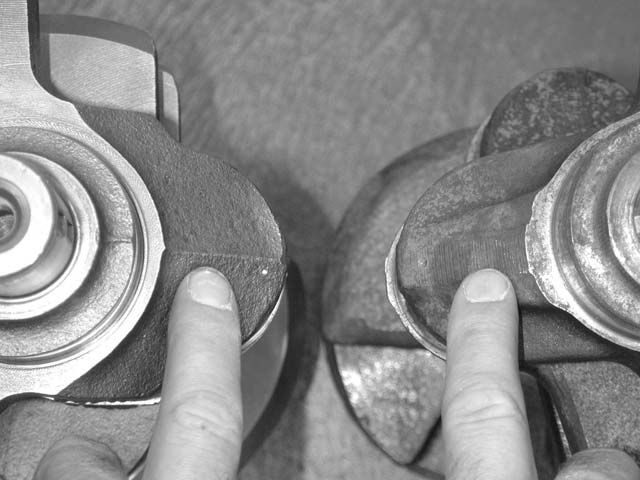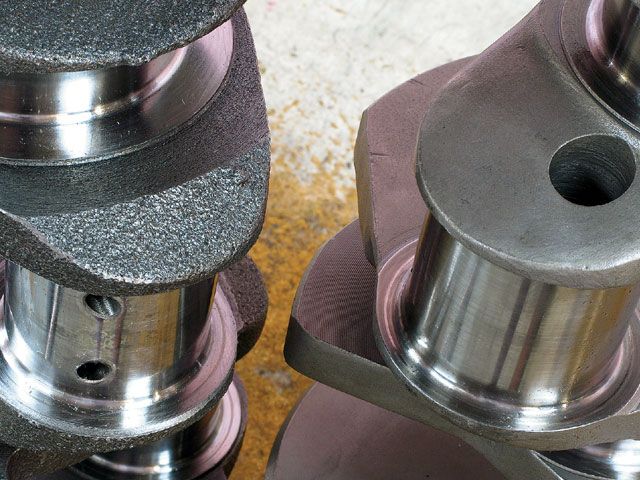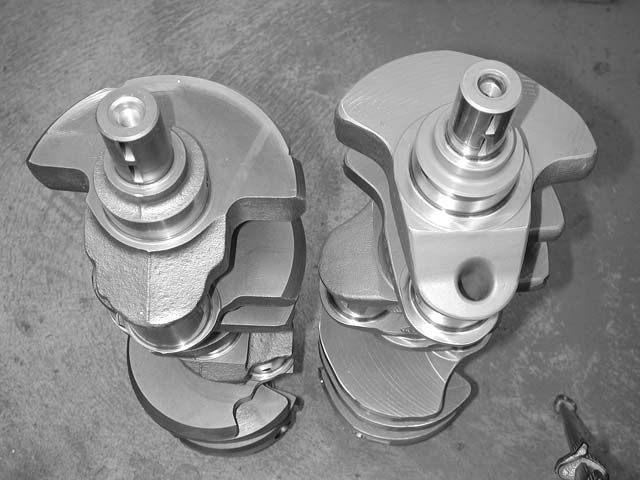I was recently asked if the difference between a cast crank and rods at $1200, vs FORGED at $1600 was worth the difference in cost by a guy who fully intends to race the car and has a high probability of using nitrous...
"
Engine Balance: Internal vs. External
An engine must be balanced to ensure smooth operation. It minimizes vibration and maximizes engine life. Balancing can be internal, external, or a combination of both.
Balancing an engine means offsetting the weight of the pistons and rods. This involves adding or removing weight from the crankshaft. The Harmonic Balancer and/or the flexplate or flywheel can also be weighted.
Internal Balance
An internally balanced engine has all the counterweight on the crank. External parts like the balancer and flexplate/flywheel have a neutral balance. They will not affect the other rotating parts.
External Balance
If the crank's counterweights are too light, the engine must be externally balanced. This involves adding weight to the harmonic balancer and/or the flexplate or flywheel.
How does it affect performance?
Generally speaking, internal balance is the better option. External counterweights can cause the crankshaft to flex at high rpm. This can cause engine damage. However, either type of balance is fine for most engines.
Converting from external to internal balance can be expensive. It requires a new crankshaft, harmonic balancer, and/or flywheel or flexplate. You may also need to clearance the block for the larger counterweights. Unless you're racing, it's easiest to balance the engine the same way the factory did.
Engine Type Factory Balance Method
Chevy 305/350 (2-piece rear main seal) Internal
Chevy 396-427 Big Blocks
Chevy LS Engines
Ford Modular Engines
Chevy 400/454 External
Ford 302/351W
Chevy 350 (1-piece rear main seal, including LT1) Combination of Internal & External
Notes
Balanced Rotating Assemblies come pre-balanced from the manufacturer. These can be installed without taking the parts to the machine shop.
If you buy an Unbalanced Rotating Kit, you will need to have it balanced before it's installed. The same is true if you buy a crankshaft, connecting rods, and pistons separately.
Crankshafts are listed as internal or external balance. This doesn't mean it's already balanced. It just tells you how it's intended to be balanced. It must be checked with the specific piston and rod combination you use.
ITS ALMOST ALWAYS A BETTER IDEA to buy a matched balanced kit with all components supplied from a single source
heres a few IVE used with good results
http://chevyhighperformance.automotive. ... index.html
viewtopic.php?f=53&t=3540
viewtopic.php?f=54&t=8463&p=29691&hilit=piston+squirters#p29691
http://www.ohiocrank.com/rotatepage1.html
http://www.dougherbert.com/enginecompon ... 5f1f37f9e5
http://www.hotrod.com/howto/69883_strok ... index.html
http://www.popularhotrodding.com/tech/0 ... to_06.html
http://www.hotrod.com/howto/7234_cranks ... index.html
http://www.adperformance.com/index.php? ... ath=71_231
INTERNALLY BALANCED (SCAT, or LUNATI, or CROWER) 4340 steel FORGED KITS WITH 7/16" ARP rod bolts and clevite (H) bearings, and forged pistons are preferred in most cases, the scat 9000 cast steel cranks work ok for mild performance applications but INSIST on 7/16" ARP ROD BOLT RODS and ID strongly suggest INTERNAL BALANCING
you may find this info useful, on CRANK SHAFT STRENGTH
MATERIAL....................TENSILE STRENGTH.....PSI.
CAST
CAST IRON.....................APROX 75,000
NODULAR IRON................APROX 95,000
CAST STEEL...................APROX 105,000
FORGED
5140 forged steel.............APROX 115,000
4130.forged.....................aprox 123,000
4340 forged.....................aprox 143,000
think of it this way if you buy the cast/hyper deal you've WASTED $1200 PLUS, AND you'll need to spend an additional $1700,-1900 PLUS, the gaskets and machine shop costs if you ever want to upgrade, if you buy the forged set up you spent about $400 more than you wanted to but you'll never need to upgrade
you'll either spend the extra $450 up front or about $3000 total later????
you'll do fine with a cast steel crank and hyper pistons in a daily driver with about 400 hp,
but once your up into the 400HP-450hp plus range you should be thinking SERIOUSLY about FORGED COMPONENTS, buying a good quality forged and balanced rotating assembly is a bit like having several fire extinguishers in the shop, you hope the full intended strength or qualities are never used but its nice to know its there, even if its not needed frequently
in ANY supercharged or high rpm combo you'll be much better off with FORGED 2618 alloy pistons, hyper-eutectic pistons work great in low stress conditions but detonation ,heat, and high stress tend to damage them far faster than forged designs,detonation ,heat, and high stress and lack of cooling lube will kill any piston but forged designs tend to run for longer under the abuse before problems arise
So Grumpy, just to make sure I understand, you think I should buy the better kit? You're kinda riding the fence.
Just kidding, I get the feeling that if you could reach thru the computer you would be vigorously shaking me back and forth yelling "spend the freaking money"
"I get the feeling that if you could reach thru the computer you would be vigorously shaking me back and forth yelling "spend the freaking money"
that's .......what I get for using a cheap VOODOO DOLL,........... NEVER TRY TO USE LOW PRICE PARTS ON CRITICAL COMPONENTS
your NOT getting the message full strength if your only getting a (FEELING)......
by now you should be having SEVERAL REALLY NASTY 9 foot tall demons bouncing you off the wall and ceiling and having the
"spend the freaking money"
in flames on the wall, if the stupid VOODOO DOLL was working correctly
I posted this before
""5140 or 4340 ? Get the Facts and End the Confusion."
Before we can answer the question "which metal do I need in my crankshaft". I think we need to take a moment and review just what each metal is made of and what are the best applications for each. In the following discussion we will see the strengths and weaknesses of each and with this information we will be able to decide which Crankshaft material will best fit our needs.
Starting with the basics, metals containing primarily iron are classified as "ferrous metals". They range from pure iron through exotic high-alloy steels. Stock Crankshafts are made from cast iron, a metallic iron with more than 2 percent dissolved carbon. One preferred variation, ductile or nodular iron has all its carbon contained in the form of tiny spherical graphite nodules uniformly dispersed throughout the metal's matrix. This makes the material more ductile (deformable rather than brittle) and eases casting and machining.
Even the best cast iron has only limited tensile strength. Increasing ductility, hardness, malleability and fatigue resistance requires removing most carbon and at the high end, alloying iron with other elements, creating "steel" an iron with less than 2 percent carbon
The most basic form of this is carbon steel, which contains up to 1.7 percent carbon and minimal additional alloying elements. Carbon steels are designated by a four digit number. The first two digits indicate the basic type, and the last two digits indicate the approximate midpoint of the carbon content. The "10" ID's these alloys as non-resulfurized carbon steel with some manganese (popularly called medium-carbon or mild steel). The second two digits the "45" or "53" means the steel contains about 0.45 or 0.53 percent carbon respectively. Stock forged OEM cranks are usually made from 1045 or 1053 steel. There are exceptions to this, some 350 high performance steel cranks in the sixties were made from 5140 and some manufactures offer 5140 or 4340 in their high performance aftermarket catalogs.
From these mild OEM steels the next step up is Alloy steel. Alloy steels allow for more variations depending on the alloying materials. Over time as manufacturing techniques improved and chemical knowledge grew., metallurgist developed whole families of alloy steels, custom-tailored to make metals stronger, lighter, more durable, more ductile, and harder. Alloy steels are also identified by a four-digit number, with the first two digits indicating the major alloying element or elements, with the last two digits indicating the approximate midpoint of the carbon range.
We will now examine the four most common groups of steel, we will examine their best uses and hopefully come up with a buying criteria for making a decision on our crankshaft purchase. We want our purchase to be based on knowledge of the product and its intended use.
4130 The best known chrome-moly steel. It is a high-strength/high-stress alloy when produced in thin sections (sheet metal and tubing). But 4130 possesses very poor deep heat-treating characteristics which make it a bad choice for machined or forged parts.
--------------------------------------------------------------------------------
4140 A deep-hardening chrome-moly steel , it forges well and has good impact resistance, fatigue strength and general all around toughness.
--------------------------------------------------------------------------------
4340 A nickel-chrome-moly steel, this alloy is used to make premium cranks.4340 has good tensile strength, toughness, and fatigue resistance. Modified 4340 alloys with vanadium and more silicon can make this already good alloy even tougher and more fatigue-resistant. The main drawback is cost.
--------------------------------------------------------------------------------
5140 This chromium alloy increases tensile strength, hardness, toughness, and wear-resistance over carbon steel. It has the same basic elements of 4340 and is made with the same process but is more affordable.
--------------------------------------------------------------------------------
So what can we conclude from this short primer. Our first conclusion is that we don't want to purchase a crank made from 4130. The lack of deep heat treating properties makes it unacceptable for most performance applications. That leaves us with 5140 and 4340. Of the two we feel 5140 is the crankshaft material that suits most clients needs. Reason #1, based on feedback from clients using our cranks the 5140 crankshaft lasts as long as the 4340 when used in all but the most extreme racing conditions. For applications where the engine is putting out 800hp or less and turning 8,000rpm or less, 5140 is the right choice. Reason #2, in engine building you save money where ever you can, if it doesn't effect the performance or durability of the engine and our 5140 crankshafts are priced 30-40% below 4340 crankshafts in cost.
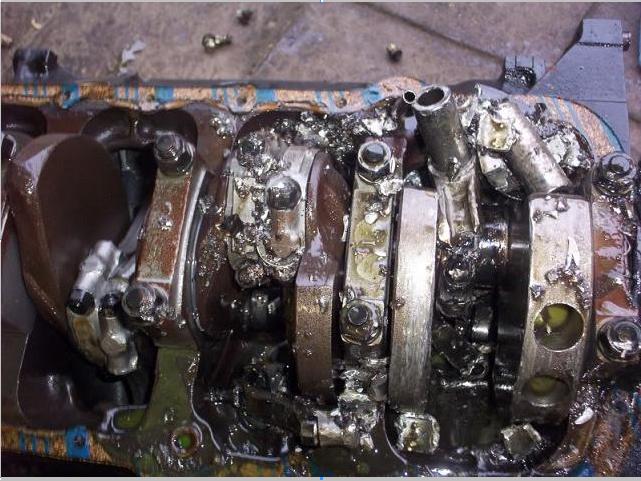
failure to verify clearances, verify valve train geometry , provide lubrication, and maintain cooling , stay out of DETONATION,or use of inferior components or exceeding your engines valve train control limitations, or red line on rotating assembly design strength can get darn expensive
short answer,forged is best, cast steel is significantly stronger than plain cast iron and can be slightly more flexable, unfortunately, as the quality gets better the cost gets higher, and your connecting rods are FAR more likely to fail than the crank in most engine combos below about 6500rpm
http://machinistinfo.com/types_of_cast_iron.htm
http://www.key-to-steel.com/Articles/Art1.htm
http://www.seaportsteel.com/TechHeat.htm
http://crankshaftspecialist.net/cryogenics.html
http://www.campbellenterprises.com/cran ... cranks.htm
http://carcraft.com/techarticles/116_03 ... ndex1.html"
"Cast cranks weight less so the engine will rev quicker (like a light flywheel)"
thats a very comon MYTH!
keep in mind each crank casting or forging can be a totally differant design, and that the machine work done,and the weight of the total rotating assembly must be taken into account.
forged cranks can and frequently ARE lighter in weight , mosty of the weight is located in counter weights, a forged crank is generally used with FORGED rods and pistons and forged pistons and rods can be made both stronger and lighter at any given strength level, lighter rods/pistons allow for lighter counter weights.
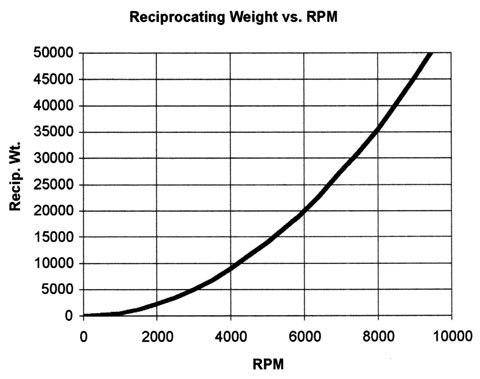
lets do a bit of math with a high rpm 383 combo, it might help here
lets take this connecting rod (645 grams)
http://www.summitracing.com/parts/ESP-6000B3D/
this piston (527 grams)
http://www.summitracing.com/parts/UEM-9909HC-060/
and just temporarily ignore the rings,and bearing weight
thats about 18210 grains at 4500 fpm in piston speed thats 75 ft per second
6588 inertial pounds the piston weights at just over 7000rpm, and your looking to reverse its direction of travel , at over 116 times PER SECOND at 7000 rpm, effectively doubling even that load of the stress on the exhaust stroke ,if you don,t think thats absolutely amazing that its potentially possible to do without instantly self destructing you have zero grasp on the potential levels of stress, then we add the fact that theres potentially 600 psi of pressure on the power stroke over a piston or about 7700 pounds resisting the piston on the power stroke but not on the next exhaust stroke and it mind boggling it holds together for even a second or two if we throw in the rings and bearing weights
http://www.summitracing.com/parts/ESP-6000B3D/
example
http://www.scatcrankshafts.com/PDFs/ScatCrank07.pdf
if you compare carefully you'll see the BETTER forged cranks are LIGHTER than the BETTER cast cranks and the weights of both cast and forged cranks vary with the stroke and extent and quality of the machine work
the engine with the lighter rotating assembly only revs quicker in neutral, when its doing work (IE THE TRANS IS GETTING THE POWER TO THE REAR ) the car can only accelerate as fast as the CAR and tires,ETC will allow it to,
So true.
"
Engine Balance: Internal vs. External
An engine must be balanced to ensure smooth operation. It minimizes vibration and maximizes engine life. Balancing can be internal, external, or a combination of both.
Balancing an engine means offsetting the weight of the pistons and rods. This involves adding or removing weight from the crankshaft. The Harmonic Balancer and/or the flexplate or flywheel can also be weighted.
Internal Balance
An internally balanced engine has all the counterweight on the crank. External parts like the balancer and flexplate/flywheel have a neutral balance. They will not affect the other rotating parts.
External Balance
If the crank's counterweights are too light, the engine must be externally balanced. This involves adding weight to the harmonic balancer and/or the flexplate or flywheel.
How does it affect performance?
Generally speaking, internal balance is the better option. External counterweights can cause the crankshaft to flex at high rpm. This can cause engine damage. However, either type of balance is fine for most engines.
Converting from external to internal balance can be expensive. It requires a new crankshaft, harmonic balancer, and/or flywheel or flexplate. You may also need to clearance the block for the larger counterweights. Unless you're racing, it's easiest to balance the engine the same way the factory did.
Engine Type Factory Balance Method
Chevy 305/350 (2-piece rear main seal) Internal
Chevy 396-427 Big Blocks
Chevy LS Engines
Ford Modular Engines
Chevy 400/454 External
Ford 302/351W
Chevy 350 (1-piece rear main seal, including LT1) Combination of Internal & External
Notes
Balanced Rotating Assemblies come pre-balanced from the manufacturer. These can be installed without taking the parts to the machine shop.
If you buy an Unbalanced Rotating Kit, you will need to have it balanced before it's installed. The same is true if you buy a crankshaft, connecting rods, and pistons separately.
Crankshafts are listed as internal or external balance. This doesn't mean it's already balanced. It just tells you how it's intended to be balanced. It must be checked with the specific piston and rod combination you use.
ITS ALMOST ALWAYS A BETTER IDEA to buy a matched balanced kit with all components supplied from a single source
heres a few IVE used with good results
http://chevyhighperformance.automotive. ... index.html
viewtopic.php?f=53&t=3540
viewtopic.php?f=54&t=8463&p=29691&hilit=piston+squirters#p29691
http://www.ohiocrank.com/rotatepage1.html
http://www.dougherbert.com/enginecompon ... 5f1f37f9e5
http://www.hotrod.com/howto/69883_strok ... index.html
http://www.popularhotrodding.com/tech/0 ... to_06.html
http://www.hotrod.com/howto/7234_cranks ... index.html
http://www.adperformance.com/index.php? ... ath=71_231
INTERNALLY BALANCED (SCAT, or LUNATI, or CROWER) 4340 steel FORGED KITS WITH 7/16" ARP rod bolts and clevite (H) bearings, and forged pistons are preferred in most cases, the scat 9000 cast steel cranks work ok for mild performance applications but INSIST on 7/16" ARP ROD BOLT RODS and ID strongly suggest INTERNAL BALANCING
you may find this info useful, on CRANK SHAFT STRENGTH
MATERIAL....................TENSILE STRENGTH.....PSI.
CAST
CAST IRON.....................APROX 75,000
NODULAR IRON................APROX 95,000
CAST STEEL...................APROX 105,000
FORGED
5140 forged steel.............APROX 115,000
4130.forged.....................aprox 123,000
4340 forged.....................aprox 143,000
think of it this way if you buy the cast/hyper deal you've WASTED $1200 PLUS, AND you'll need to spend an additional $1700,-1900 PLUS, the gaskets and machine shop costs if you ever want to upgrade, if you buy the forged set up you spent about $400 more than you wanted to but you'll never need to upgrade
you'll either spend the extra $450 up front or about $3000 total later????
you'll do fine with a cast steel crank and hyper pistons in a daily driver with about 400 hp,
but once your up into the 400HP-450hp plus range you should be thinking SERIOUSLY about FORGED COMPONENTS, buying a good quality forged and balanced rotating assembly is a bit like having several fire extinguishers in the shop, you hope the full intended strength or qualities are never used but its nice to know its there, even if its not needed frequently
in ANY supercharged or high rpm combo you'll be much better off with FORGED 2618 alloy pistons, hyper-eutectic pistons work great in low stress conditions but detonation ,heat, and high stress tend to damage them far faster than forged designs,detonation ,heat, and high stress and lack of cooling lube will kill any piston but forged designs tend to run for longer under the abuse before problems arise
So Grumpy, just to make sure I understand, you think I should buy the better kit? You're kinda riding the fence.
Just kidding, I get the feeling that if you could reach thru the computer you would be vigorously shaking me back and forth yelling "spend the freaking money"
"I get the feeling that if you could reach thru the computer you would be vigorously shaking me back and forth yelling "spend the freaking money"
that's .......what I get for using a cheap VOODOO DOLL,........... NEVER TRY TO USE LOW PRICE PARTS ON CRITICAL COMPONENTS
your NOT getting the message full strength if your only getting a (FEELING)......
by now you should be having SEVERAL REALLY NASTY 9 foot tall demons bouncing you off the wall and ceiling and having the
"spend the freaking money"
in flames on the wall, if the stupid VOODOO DOLL was working correctly
I posted this before
""5140 or 4340 ? Get the Facts and End the Confusion."
Before we can answer the question "which metal do I need in my crankshaft". I think we need to take a moment and review just what each metal is made of and what are the best applications for each. In the following discussion we will see the strengths and weaknesses of each and with this information we will be able to decide which Crankshaft material will best fit our needs.
Starting with the basics, metals containing primarily iron are classified as "ferrous metals". They range from pure iron through exotic high-alloy steels. Stock Crankshafts are made from cast iron, a metallic iron with more than 2 percent dissolved carbon. One preferred variation, ductile or nodular iron has all its carbon contained in the form of tiny spherical graphite nodules uniformly dispersed throughout the metal's matrix. This makes the material more ductile (deformable rather than brittle) and eases casting and machining.
Even the best cast iron has only limited tensile strength. Increasing ductility, hardness, malleability and fatigue resistance requires removing most carbon and at the high end, alloying iron with other elements, creating "steel" an iron with less than 2 percent carbon
The most basic form of this is carbon steel, which contains up to 1.7 percent carbon and minimal additional alloying elements. Carbon steels are designated by a four digit number. The first two digits indicate the basic type, and the last two digits indicate the approximate midpoint of the carbon content. The "10" ID's these alloys as non-resulfurized carbon steel with some manganese (popularly called medium-carbon or mild steel). The second two digits the "45" or "53" means the steel contains about 0.45 or 0.53 percent carbon respectively. Stock forged OEM cranks are usually made from 1045 or 1053 steel. There are exceptions to this, some 350 high performance steel cranks in the sixties were made from 5140 and some manufactures offer 5140 or 4340 in their high performance aftermarket catalogs.
From these mild OEM steels the next step up is Alloy steel. Alloy steels allow for more variations depending on the alloying materials. Over time as manufacturing techniques improved and chemical knowledge grew., metallurgist developed whole families of alloy steels, custom-tailored to make metals stronger, lighter, more durable, more ductile, and harder. Alloy steels are also identified by a four-digit number, with the first two digits indicating the major alloying element or elements, with the last two digits indicating the approximate midpoint of the carbon range.
We will now examine the four most common groups of steel, we will examine their best uses and hopefully come up with a buying criteria for making a decision on our crankshaft purchase. We want our purchase to be based on knowledge of the product and its intended use.
4130 The best known chrome-moly steel. It is a high-strength/high-stress alloy when produced in thin sections (sheet metal and tubing). But 4130 possesses very poor deep heat-treating characteristics which make it a bad choice for machined or forged parts.
--------------------------------------------------------------------------------
4140 A deep-hardening chrome-moly steel , it forges well and has good impact resistance, fatigue strength and general all around toughness.
--------------------------------------------------------------------------------
4340 A nickel-chrome-moly steel, this alloy is used to make premium cranks.4340 has good tensile strength, toughness, and fatigue resistance. Modified 4340 alloys with vanadium and more silicon can make this already good alloy even tougher and more fatigue-resistant. The main drawback is cost.
--------------------------------------------------------------------------------
5140 This chromium alloy increases tensile strength, hardness, toughness, and wear-resistance over carbon steel. It has the same basic elements of 4340 and is made with the same process but is more affordable.
--------------------------------------------------------------------------------
So what can we conclude from this short primer. Our first conclusion is that we don't want to purchase a crank made from 4130. The lack of deep heat treating properties makes it unacceptable for most performance applications. That leaves us with 5140 and 4340. Of the two we feel 5140 is the crankshaft material that suits most clients needs. Reason #1, based on feedback from clients using our cranks the 5140 crankshaft lasts as long as the 4340 when used in all but the most extreme racing conditions. For applications where the engine is putting out 800hp or less and turning 8,000rpm or less, 5140 is the right choice. Reason #2, in engine building you save money where ever you can, if it doesn't effect the performance or durability of the engine and our 5140 crankshafts are priced 30-40% below 4340 crankshafts in cost.

failure to verify clearances, verify valve train geometry , provide lubrication, and maintain cooling , stay out of DETONATION,or use of inferior components or exceeding your engines valve train control limitations, or red line on rotating assembly design strength can get darn expensive
short answer,forged is best, cast steel is significantly stronger than plain cast iron and can be slightly more flexable, unfortunately, as the quality gets better the cost gets higher, and your connecting rods are FAR more likely to fail than the crank in most engine combos below about 6500rpm
http://machinistinfo.com/types_of_cast_iron.htm
http://www.key-to-steel.com/Articles/Art1.htm
http://www.seaportsteel.com/TechHeat.htm
http://crankshaftspecialist.net/cryogenics.html
http://www.campbellenterprises.com/cran ... cranks.htm
http://carcraft.com/techarticles/116_03 ... ndex1.html"
"Cast cranks weight less so the engine will rev quicker (like a light flywheel)"
thats a very comon MYTH!
keep in mind each crank casting or forging can be a totally differant design, and that the machine work done,and the weight of the total rotating assembly must be taken into account.
forged cranks can and frequently ARE lighter in weight , mosty of the weight is located in counter weights, a forged crank is generally used with FORGED rods and pistons and forged pistons and rods can be made both stronger and lighter at any given strength level, lighter rods/pistons allow for lighter counter weights.

lets do a bit of math with a high rpm 383 combo, it might help here
lets take this connecting rod (645 grams)
http://www.summitracing.com/parts/ESP-6000B3D/
this piston (527 grams)
http://www.summitracing.com/parts/UEM-9909HC-060/
and just temporarily ignore the rings,and bearing weight
thats about 18210 grains at 4500 fpm in piston speed thats 75 ft per second
6588 inertial pounds the piston weights at just over 7000rpm, and your looking to reverse its direction of travel , at over 116 times PER SECOND at 7000 rpm, effectively doubling even that load of the stress on the exhaust stroke ,if you don,t think thats absolutely amazing that its potentially possible to do without instantly self destructing you have zero grasp on the potential levels of stress, then we add the fact that theres potentially 600 psi of pressure on the power stroke over a piston or about 7700 pounds resisting the piston on the power stroke but not on the next exhaust stroke and it mind boggling it holds together for even a second or two if we throw in the rings and bearing weights
http://www.summitracing.com/parts/ESP-6000B3D/
example
http://www.scatcrankshafts.com/PDFs/ScatCrank07.pdf
if you compare carefully you'll see the BETTER forged cranks are LIGHTER than the BETTER cast cranks and the weights of both cast and forged cranks vary with the stroke and extent and quality of the machine work
the engine with the lighter rotating assembly only revs quicker in neutral, when its doing work (IE THE TRANS IS GETTING THE POWER TO THE REAR ) the car can only accelerate as fast as the CAR and tires,ETC will allow it to,
So true.
Last edited by a moderator:


